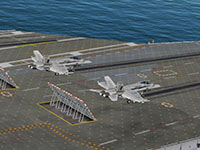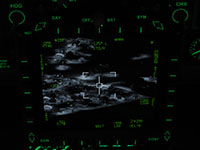

Campaigns are the top level events of flight activity within Virtual Carrier Air Wing One. These are multiple mission scenarios with a specific overall objective, often - but not always - based upon real world events. The typical length of campaign scenarios varies, but on average they run between six to eight missions, which are run once a week over a period of several weeks. These events are what we train and practice for, and as such there is a higher level of expectation as far as adhering to protocols and flight procedures - we try to fly campaign missions under with the "as real as it gets" mentality where surviving the mission is the primary goal.
While many of our so-called pick-up flights allow for respawning and getting back into the air after a pilot crashes or is shot down, campaign missions are flown under the idea of "dead is dead" - in other words, if a pilot is shot down, destroyed, or killed, that's it - their mission is over.
Campaigns are also tracked differently than standard Flight Log entries, with each campaign eventually showing a detailed analysis of the results - total sorties, enemy planes shot down, ground and ship targets hit, and pilots shot down. In addition, future campaigns will include campaign ribbons and patches that will be displayed in each participating pilot's Pilot Locker.
Campaign Mission Design
Virtual Carrier Air Wing One has a group of dedicated members who design the missions for our campaigns. These members have significant experience with the Digital Combat Simulator mission editor, and utilize all the tools available - including third party scripting tools such as MOOSE and MIST - to develop missions for our campaigns. These missions are developed with a realistic framework in mind - not all missions in real life, even under high alert or Yellow or Red Rules of Engagement, include shooting missiles and dropping bombs, and in our case this is also true. Most missions will include some combat action of course, but this depends entirely upon the premise of the campaign. Our mission designers use scripting and trigger tools to develop detailed events, in most cases complete with included sound bites and voice acted radio calls, that enhance the realism and immersion of our campaign missions and provide exciting, tense, and complex situations that require teamwork to complete successfully.
In addition, occasionally we run campaigns that are designed to be run from a historical perspective - for example, campaigns run in the late 1990's or early 2000's time frame - that require us to use weapons appropriate for that time period. This means utilizing older weaponry and equipment, such as AIM-7 Sparrow and AIM-9M Sidewinder missiles or non stand-off air to ground weapons like Mark-82 dumb bombs or Laser Guided Munitions. Naturally this adds an increasing level of complexity and difficulty to the campaign and it's overall success, and requires increasing levels of teamwork and systems utilization to get the job done in the target area.
Campaign Mission Execution
Flying our campaigns is where all the training, teamwork, and practice is finally put to the ultimate test.

Each mission begins with a detailed briefing, which includes all levels of detail regarding the current situation, known intelligence on enemy air or anti-aircraft assets, target data and information, and other known enemy assets or information pertinent to the mission at hand. Additional information is provided related to the flight itself - a breif on the weather conditions and time, which determines the take off and landing conditions from the carrier, and all known friendly assets which includes AWACS, tanker support (typically at least one long distance tanker along with the fleet SB-3 "Trick or Treat" bird), and any other friendly assets relevant to the mission tasking. Carrier information is also provided - including heading, BRC and Final Bearing, and what procedures are in effect (CASE I, CASE II, or CASE III). In some cases this briefing information is also included in the mission as a Kneeboard (which is significantly helpful to those who fly in VR).
Flight assignments are briefed. Typically, these assignments will have been pre-determined, but member availability can sometimes require flight assignment changes. Each flight's tasking orders will be gone over in detail. Radio information will be covered, with each flight receiving it's Auxiliary channel assignment and cypher along with it's tactical ID to be used while transmitting on Primary with mission tasking and AWACS. Typically, flights are set as either a two or four ship flight to ensure everyone has a wingman in the event of a merge with enemy planes.
Once the breifing is completed, the flight commences. Pilots connect to the server and load onto the carrier deck according to flight assignments - usually in the order of CAP / BARCAP first, followed by any SEAD flight, then all strike flights.
Campaign Post Mission Information
Once the flight is complete, the standard mission de-briefing is conducted, but with more detailed examination of the results of the flight and how it affects the overall campaign objectives. Pilots log their flights into their Flight Logbook, making any notes they wish pertaining to the mission. A post-mission after action report is then prepared that details the results of the mission and how its success or failure affects the current military and political situation related to the campaign synopsis.
The results of each campaign mission generally determine the events of the next mission. As an example, if the wing is assigned to destroy several groups of Silkworm missile sites, and only achieve part of their objective by destroying only half of them, the next mission will likely be a strike to destroy the remaining sites - with an increased enemy presence and difficulty considering they'll be expecting additional strikes.


